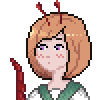
Hey, now, you would've smelled her coming if you weren't all wrapped up in brooding.
(The "beast quarter" in most cities where one has gotten established usually consists of neighborhoods formerly of human occupation, since fallen into neglect and abandonment. While the beastfolk who move in afterward generally take good care of their living spaces, they don't always have the means to completely remodel them - and tend to avoid it in places of business anyway, since there's significantly greater variation in size among beastfolk than humans and you don't want to make your customers feel cramped just 'cause you happen to be 2-3' tall.
Longtime residents have figured out ways of dealing with this. New and/or newly-nonhuman residents, on the other hand, may take a while to adjust.)
(The "beast quarter" in most cities where one has gotten established usually consists of neighborhoods formerly of human occupation, since fallen into neglect and abandonment. While the beastfolk who move in afterward generally take good care of their living spaces, they don't always have the means to completely remodel them - and tend to avoid it in places of business anyway, since there's significantly greater variation in size among beastfolk than humans and you don't want to make your customers feel cramped just 'cause you happen to be 2-3' tall.
Longtime residents have figured out ways of dealing with this. New and/or newly-nonhuman residents, on the other hand, may take a while to adjust.)
Category Artwork (Traditional) / TF / TG
Species Red Fox
Size 1280 x 1028px
File Size 599.9 kB
I'm getting pretty fond of her - she's a lot of fun to draw =^_^= (Used to draw fopses a lot, way back when I was first getting into the fandom, but not as much these days; drifting back to 'em ever since I started digging into the Reynard cycle earlier this year.) Gonna be a while yet before I get around to the story concept here, but it's always nice to explore the characters and setting in the meantime...
A tradition of European folktales from the Middle Ages on into the Renaissance starring Reynard the fox, usually pitted against Ysengrim the wolf in scenarios that have one foot in broad social satire and the other in proto-Looney Tunes comedic violence (albeit taken to an extent that'd give Itchy & Scratchy pause!) It was popular enough in its day that it was borrowed by Chaucer, got a shout-out in Romeo & Juliet, and actually left its mark on a language - the modern French word for "fox" is renard. (It's also very likely the reason for the fox-vs.-wolf casting in Disney's Robin Hood.)
(For my money, Ysengrimus - the first tale in which Reynard and Ysengrim are named - is actually the better work, being a very deliberate and pointed satire put together in mock-epic form by one very well-read nerd somewhere back in medieval Flanders, while the later versions of the story are more a shared tradition that probably co-evolved out of the same folkloric sources. There's good stuff in both, but you can tell the former author really knew exactly what he was doing.)
Of course, actually reading the dang things involves tracking down translations of Latin or Old French verse or working through English that's anywhere from barely-past-Middle to not-as-Modern-as-you-might-think - and on top of that, it deserves a hearty Content Warning for Things That Were Considered Funny In The Middle Ages...
...but I had to get to grips with that years ago when my dad and I started on a hastily-aborted attempt to get through the Canterbury Tales (we got as far as the Miller's Tale before abandoning the project.) It's not something that I can more than conditionally recommend, but it got me all in a mood to start drawing foxes again, so that's something ;)
(For my money, Ysengrimus - the first tale in which Reynard and Ysengrim are named - is actually the better work, being a very deliberate and pointed satire put together in mock-epic form by one very well-read nerd somewhere back in medieval Flanders, while the later versions of the story are more a shared tradition that probably co-evolved out of the same folkloric sources. There's good stuff in both, but you can tell the former author really knew exactly what he was doing.)
Of course, actually reading the dang things involves tracking down translations of Latin or Old French verse or working through English that's anywhere from barely-past-Middle to not-as-Modern-as-you-might-think - and on top of that, it deserves a hearty Content Warning for Things That Were Considered Funny In The Middle Ages...
...but I had to get to grips with that years ago when my dad and I started on a hastily-aborted attempt to get through the Canterbury Tales (we got as far as the Miller's Tale before abandoning the project.) It's not something that I can more than conditionally recommend, but it got me all in a mood to start drawing foxes again, so that's something ;)

 FA+
FA+











Comments